If you are looking for useful information about the famous Passetto di Borgo of Castel Sant’Angelo, you will find everything you need here.
In the following I will tell you about the history of the Corridor, completing the description of this important architectural work with some tidbits on how to visit it in comfort.
By the time you have finished reading, you will know all about the visiting hours, the tours of Castel Sant’Angelo involving it and their length, and you will not be unprepared either for the tickets to buy to visit it.
Read on if you want to know more about how to visit the Passetto di Borgo!
ATTENTION. Important Note: To visit the Passetto di Borgo, you can choose between two ticket options: the combined Castel Sant’Angelo + Passetto di Borgo ticket (without a guided tour) or an exclusive guided tour of the Passetto di Borgo alone. We recommend you opt for the combined ticket for a complete and immersive experience, allowing you to explore both historical wonders on your own. Don’t miss the opportunity to discover the unique charm of the Passetto di Borgo along with the castle!
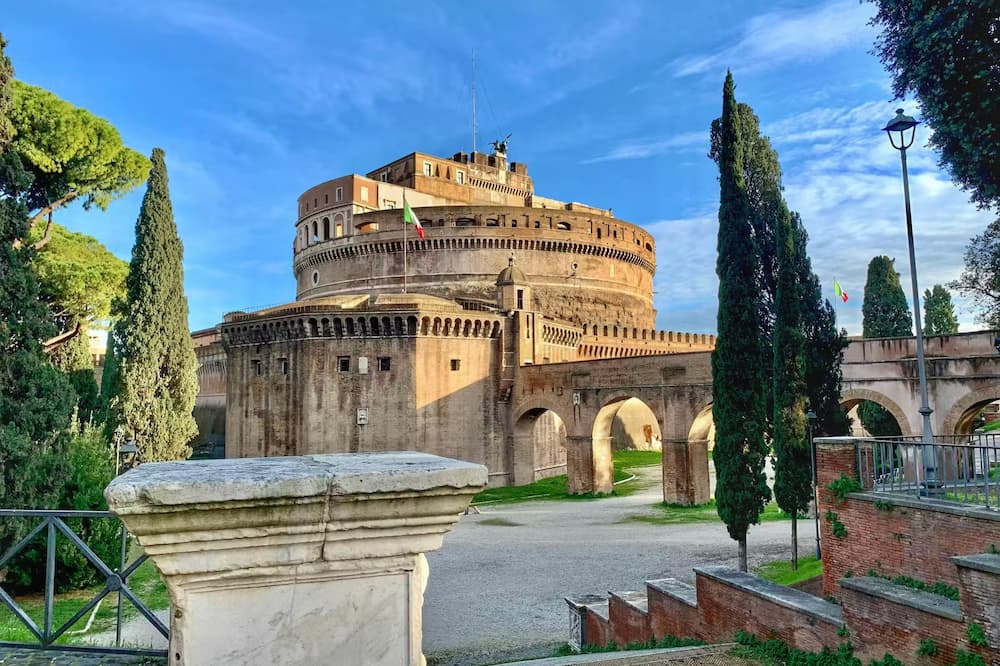
Ticket Castel Sant’Angelo + Passetto di Borgo
Purchase online and choose the time of your choice. Explore the Castel Sant’Angelo, the Ponte dell’Angelo, the prisons and the famous Passetto di Borgo in total autonomy.
You can cancel for free up to the day before the visit.
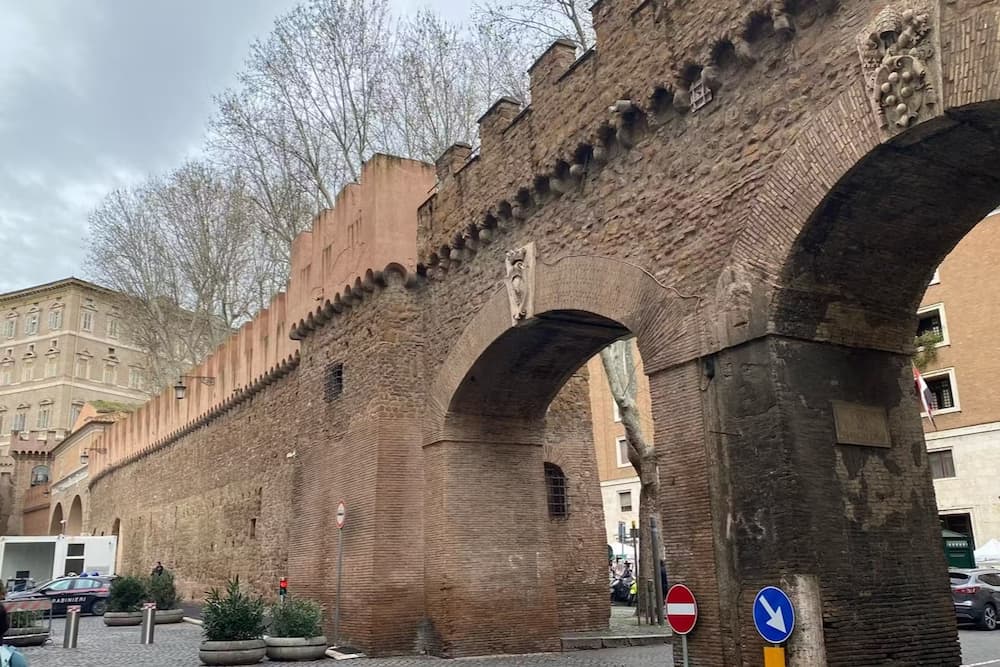
Guided tour of Passetto di Borgo
Buy online and reserve your time. Discover the history of the Passetto di Borgo with an expert guide, exploring one of Rome’s most fascinating places.
You can cancel for free up to the day before the visit.
What Is the Passetto di Borgo of Castel Sant’Angelo
Contents
- 1 What Is the Passetto di Borgo of Castel Sant’Angelo
- 2 Passetto Castel Sant’Angelo: Useful Info
- 3 Passetto di Borgo & Underground Passage: What to See
- 4 How to visit the Passetto di Borgo
- 5 Passetto di Castel Sant’Angelo Rome: Curiosities
- 6 Castel Sant’Angelo Passetto di Borgo: Tickets.
- 7 Passetto di Borgo Roma: FAQ
- 8 Vatican Passetto Castel Sant’Angelo: Conclusions
The Passetto di Borgo of Castel Sant’Angelo, also called the Corridor of Borgo, is the protected passageway connecting the Bastione San Marco of Castel Sant’Angelo to the Vatican Apostolic Palace.
More simply, it represents the passage between the Vatican and Castel Sant’Angelo.
An elevated corridor of eight hundred metres that represents the longest remaining stretch of the ancient Leonine Walls, erected by Pope Leo IV in the mid-19th century with the aim of defending the Civitas Leonina – the citadel that he named after – from the danger of Saracen invasions.
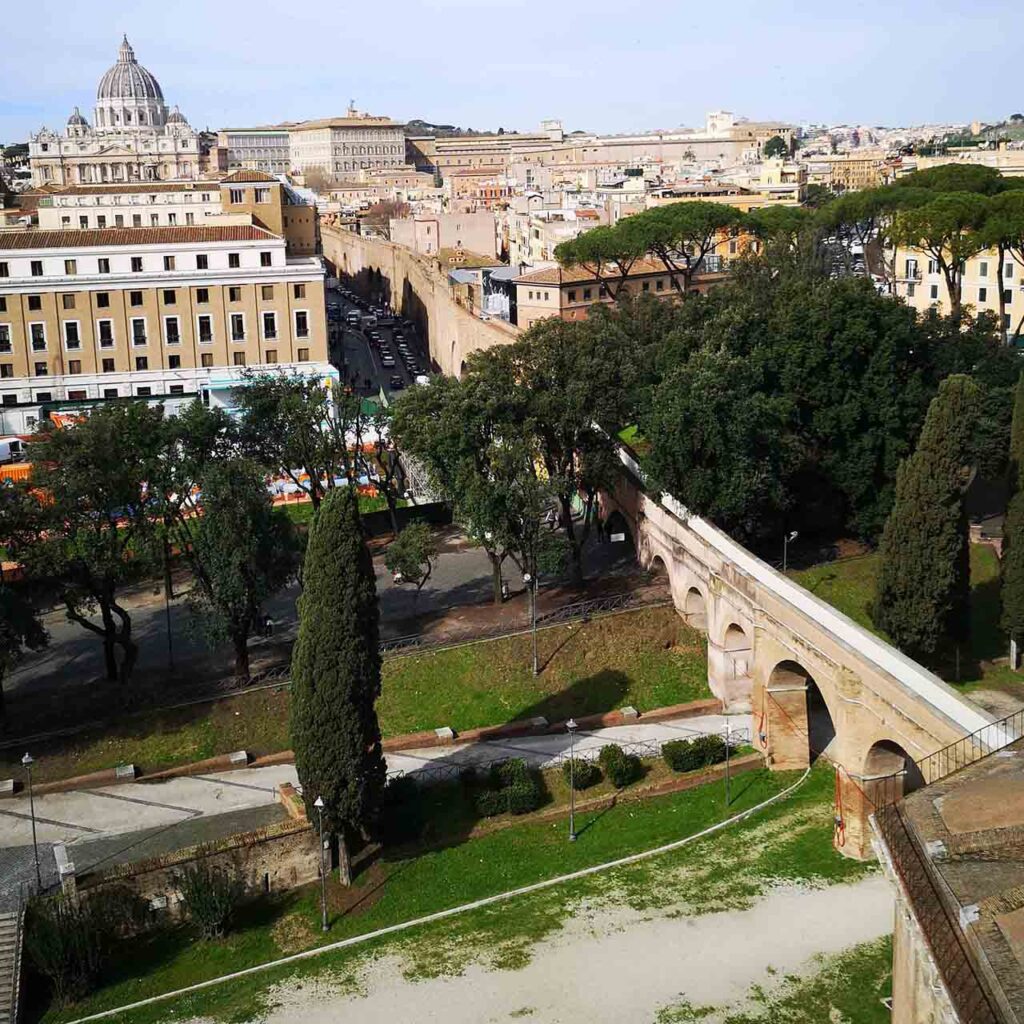
The corridor was provided with a covered passageway during the restoration of the Vatican Walls. The purpose is to provide an escape route for the popes, as well as to create a protected link between the Vatican and the Mole Adriana, already a fortress used for defensive purposes.
Who is responsible for this improvement, however, is still a matter of debate among experts. For some, it belongs to Niccolò III and the renovation he ordered in 1278, for others to Bonifacio IX who, more than a century later, is said to have initiated the work completed by Baldassarre Cossa, the anti-pope John XXIII.
Other popes would later order important improvements. In the middle of the XV century it would be the turn of Niccolò V, followed thirty years later by the works of Sisto IV.
In the early XVI century, however, it was Pope Alexander VI who ordered a massive renovation of the walls. It is not surprising, then, that the popes relied so heavily on this strategic passageway to smuggle prisoners to the prisons of Castel Sant’Angelo, as well as to take refuge in the event of a siege.
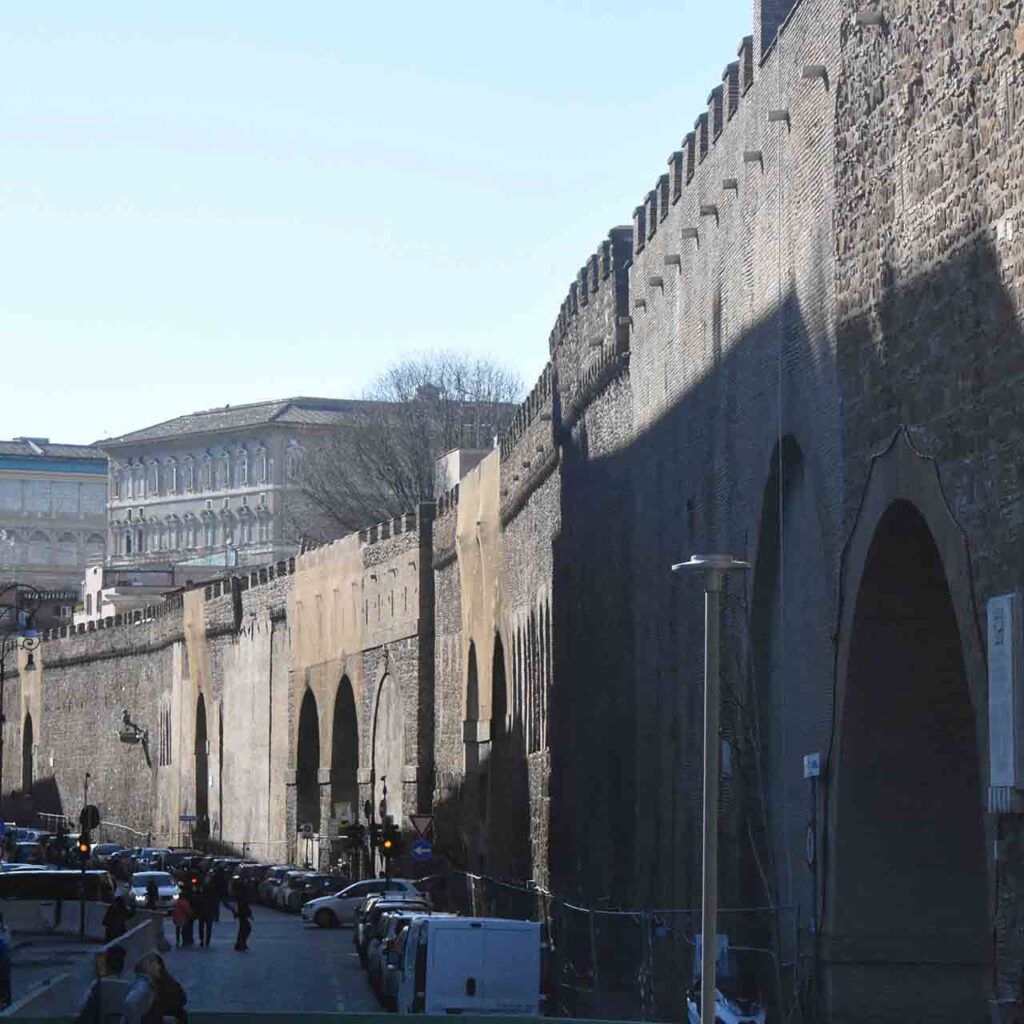
This, historically, is certainly the case in two instances: the invasion by the French militia of Carlo VIII in Carlo VIII in 1494, which saw Pope Alexander VI Borgia come to safety thanks to the Passetto, and the famous Sack of Rome perpetrated by the lansquenets of Carlo V in 1527, when Pope Clement VII took refuge in Castel Sant’Angelo while a large part of the Swiss Guard was massacred. The marks left by the arquebus shots of the German mercenaries are still visible on the walls today!
In the year 2000, on the occasion of the Jubilee proclaimed by Pope John Paul II, the Passetto di Borgo returned accessible to the public along with other important architectural works. Today, however, it is only accessible on the occasion of special guided tours.
Passetto Castel Sant’Angelo: Useful Info
- Address: Viale Giuseppe Ceccarelli, 00193 Rome RM, Italy
- Length: approximately 800 metres
- Function: secret passage
- Date of construction: circa 1278
- Date of opening to the public: 2000
- Public access: limited, guided tours only
- Tickets: Click here for more info
- Duration of visit: less than an hour

Ticket Castel Sant’Angelo + Passetto di Borgo
Purchase online and choose the time of your choice. Explore the Castel Sant’Angelo, the Ponte dell’Angelo, the prisons and the famous Passetto di Borgo in total autonomy.
You can cancel for free up to the day before the visit.

Guided tour of Passetto di Borgo
Buy online and reserve your time. Discover the history of the Passetto di Borgo with an expert guide, exploring one of Rome’s most fascinating places.
You can cancel for free up to the day before the visit.
Passetto di Borgo & Underground Passage: What to See
The Passetto of Castel S. Angelo, as well as offering a ninefold view of Rome and the Vatican from its walkway, is still inlaid with merchandises all waiting to be discovered.
Its entrance, the ancient Porta San Pellegrino enclosed between two crenellated towers, is almost entirely hidden by Bernini’s colonnade in Saint Peter’s Square. Under a small window one can still admire the stemma of Pope Alexander VI Borgia and the inscription ‘Pope Alexander VI in the year 1492’ in Latin. Today the entrance to the barracks of the Swiss Guard, among many other names the Sancti Peregrini gate is also known as the “Porta degli Svizzeri“.
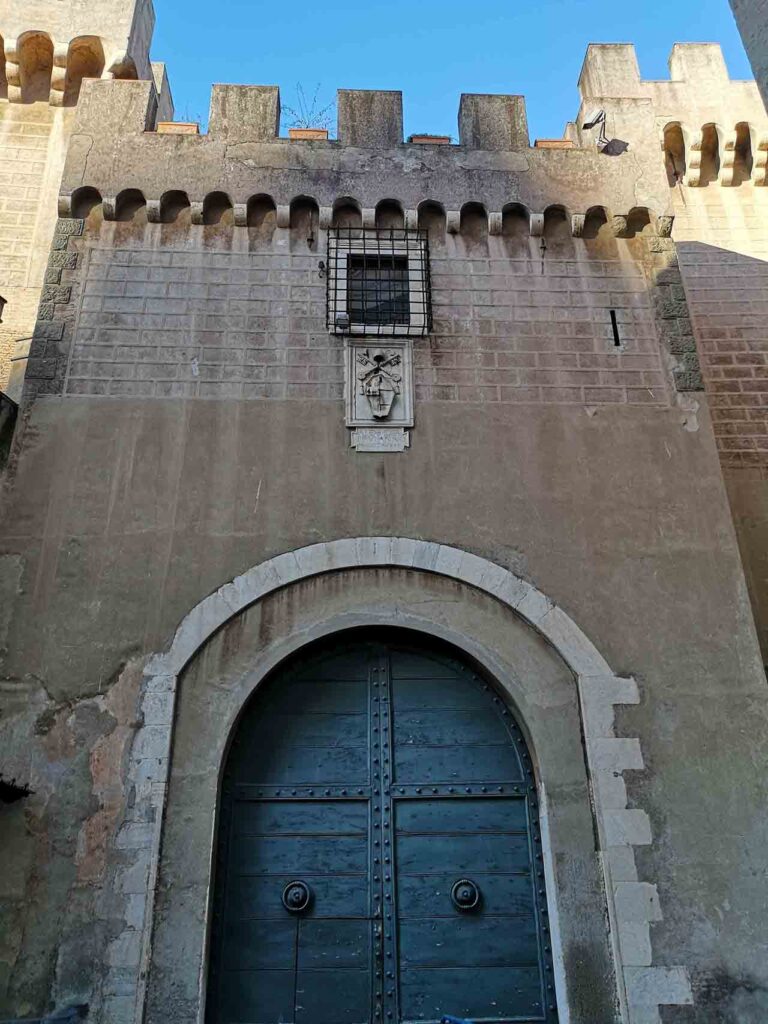
Another point of interest is located at largo Colonnato. Here, two forns were opened at very distant times: the first, the one on the left, was opened by order of Pope Pope IV in 1562, to allow the connection between the old and new Borgo; the second, on the other hand, was opened by the Commune of Rome in 1933.
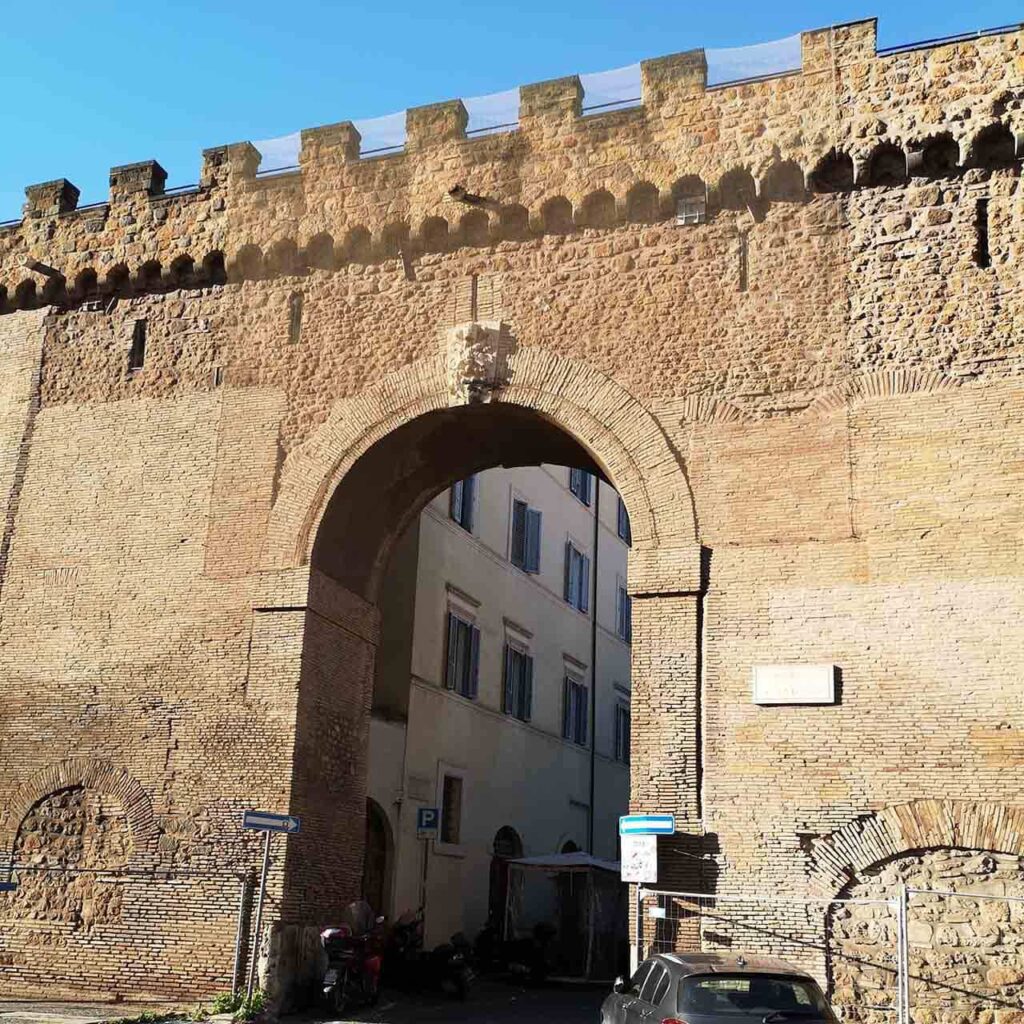
Further on we find other fornices opened by Pius IV: the one on via del Mascherino, on vicolo del Farinone, on vicolo delle Palline, vicolo delle Orfeo, vicolo del Campanile and via Porta Castello. The second archway on Via del Mascherino, as well as the one on Via di Porta Castello, would not be built until 1950 by the Municipality of Rome.
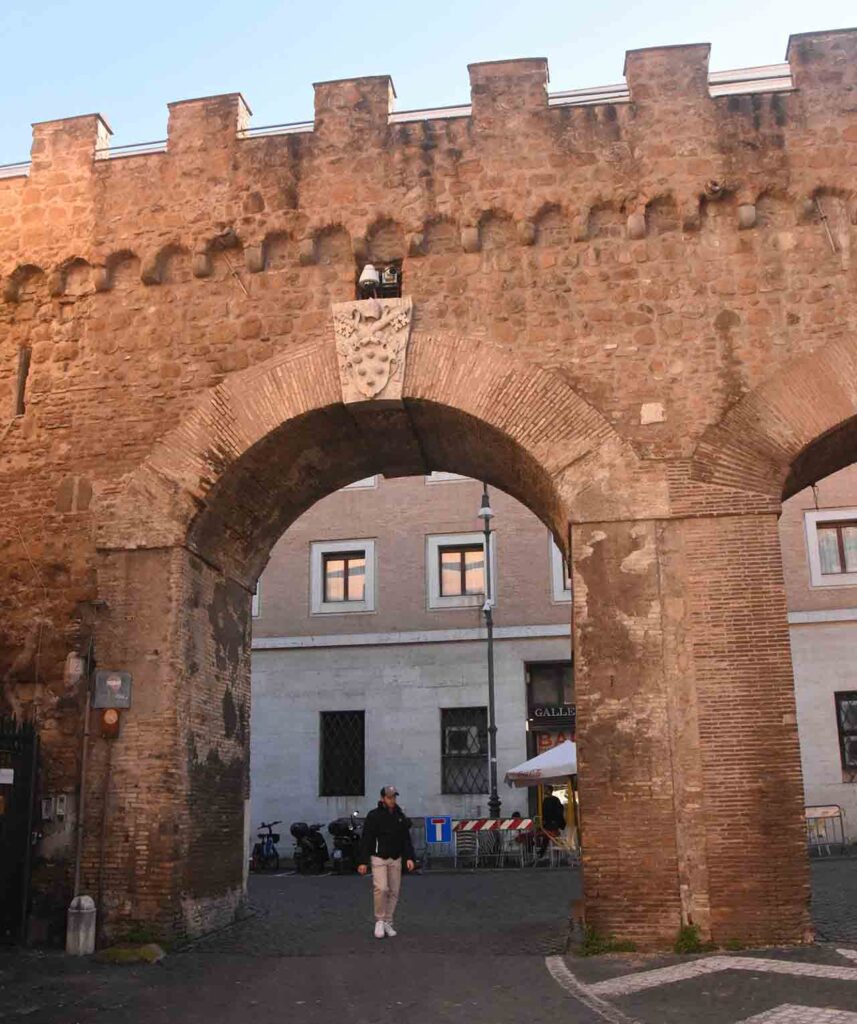
A noteworthy work is the eighteenth-century Madonnella located under the archway on Vicolo d’Orfeo in Borgo Pio: a oleography of the Madonna Addolorata, known as the Madonna del Dito, in a wooden edicule with Corinthian columns and a triangular tympanum.
While between the two archways on via Porta Castello we find the Madonna della Misericordia, placed here in 1953. This street reminds us of the history of the gate of the same name, commissioned by Pius IV in 1563 and demolished at the end of the 800s, which regulated the entrance of the processions of kings and emperors to the coronation at St Peter’s.
The last pair of archways – now open to traffic – is located at Piazza Pia, while the last eight archways bypass the ditch, the gardens of Parco Adriano and lead to the Bastione San Marco, and then to the Castel Sant’Angelo.
Mirroring, in a certain sense, the Vatican Castel Sant’Angelo Bridge is a project from 2000 that today, in view of the Jubilee 2025, is once again causing discussion. There is talk of the pedestrian underpass that would pass under Glargo Giovanni XXIII and Piazza Pia and thus allow the pedestrianisation of Via della Conciliazione and unite the Castel Sant’Angelo and San Pietro in a single promenade.
Another possibility would be to operate a shoring of the already existing tunnel known as the subway, currently passing under the Santo Spirito hospital, then just beyond the Passetto di Borgo at the beginning of Piazza Pia.

How to visit the Passetto di Borgo
The Passetto di Borgo, one of Rome’s most fascinating secret passages, can be explored in two ways, offering different experiences depending on your preferences.
Option 1: Combined ticket Castel Sant’Angelo + Passetto di Borgo
By purchasing the combined Castel Sant’Angelo + Passetto di Borgo ticket, you will have the opportunity to visit the castle and the passetto on your own. This ticket allows you to:
- Enter without standing in line thanks to priority entry
- Explore at your own pace both the Castel Sant’Angelo and the Passetto di Borgo, without the presence of a guide
It is an ideal solution for those who prefer a more independent experience, enjoying the historic sites without time constraints.
Option 2: Guided tour of the Passetto di Borgo
If you want a more immersive experience, you can opt for the guided tour of the Passetto di Borgo. This tour offers you:
- An experienced guide will take you through the passetto, telling you about the history and curiosities of the place
- Exclusive access to less-traveled areas, away from the crowds
- A more in-depth experience, which will allow you to discover historical details about how the passetto was used by the popes as an escape route
This option is perfect for those who want to learn in depth about the history of the passetto and have a unique experience.
Passetto di Castel Sant’Angelo Rome: Curiosities

Pope Alexander walking on passetto di Borgo
Here are 5 curiosities about the Passetto di Borgo of Castel Sant’Angelo:
- Before the reconstruction of part of the Leonine Walls, what we know today as the Passetto di Borgo was called ‘Lo Andare‘.
- Today, in Rome, you can hear citizens refer to the Passetto di Borgo as ‘er Coridore‘.
- Vicolo delle Palline (Alley of the Balls) is so named because of the balls that appear on the Medici coat of arms of Pope Pius IV above the left arch of today’s Porta Angelica.
- It is said that Pope Alexander VI used the Passetto di Borgo to reach the flats where he met his mistresses.
- From this rumour comes a bizarre legend: it is said that by walking seventy-seven times back and forth the eight hundred metres of the Passetto, men can recover their lost virility. A walk of just 60km!
Castel Sant’Angelo Passetto di Borgo: Tickets.
Discover the two ticket options for visiting the Passetto di Borgo of Castel Sant’Angelo Rome.

Ticket Castel Sant’Angelo + Passetto di Borgo
Purchase online and choose the time of your choice. Explore the Castel Sant’Angelo, the Ponte dell’Angelo, the prisons and the famous Passetto di Borgo in total autonomy.
You can cancel for free up to the day before the visit.

Guided tour of Passetto di Borgo
Buy online and reserve your time. Discover the history of the Passetto di Borgo with an expert guide, exploring one of Rome’s most fascinating places.
You can cancel for free up to the day before the visit.
Passetto di Borgo Roma: FAQ
The Passetto di Borgo Roma is not regularly open to the public. In order to visit it, it is necessary to purchase a specific ticket or book a guided tour. On such occasions, it is possible to walk on the Passetto di Borgo.
You can visit Castel Sant’Angelo’s Passetto on guided tours or through ticket purchase: Click here for more information.
In 1494 Pope Alexander VI Borgia used the Passetto di Borgo to take refuge in Castel Sant’Angelo during the invasion of Rome by the militia of Charles VIII of France, while in 1527 it was Pope Clemente VII who exploited the Passetto during the Sack of Rome by the lansquenets of Carlo V.
Now a museum, Castel Sant’Angelo was originally a funeral mausoleum. In the Middle Ages it was converted into a military fortress, in Modern Age it was also the papal residence, tribunal and prison of the Papal State.
Inside the Castel Sant’Angelo, you can still admire the Tomb of Hadrian, the circular staircase, the Papal lodgings, the frescoes, the Campus of the executions, the Grande Loggia, the bastions, the well-preserved halls of the fortress and much more.
Vatican Passetto Castel Sant’Angelo: Conclusions
Here we come to the end of this in-depth study on the Sonte di Borgo di Castel Sant’Angelo;
I have told you the long history of the old walls that hold it up, evoking names of popes and battles that echo through the seconds;
I have provided you with useful information on the visits you can make. I have followed with you, on foot, the entire path that the Passetto makes from the Vatican to the Bastione San Marco of Castel Sant’Angelo;
I told you about the project of the underpass and I wanted to bring you up to date with some of the most interesting curiosities concerning the Corridor of Borgo;
I have also answered the questions that are asked most frequently.
If you need more information, please leave a comment below; however, if you would like to visit the Castle, please purchase your entrance ticket by skipping the ticket line at the ticket office.

Ticket Castel Sant’Angelo + Passetto di Borgo
Purchase online and choose the time of your choice. Explore the Castel Sant’Angelo, the Ponte dell’Angelo, the prisons and the famous Passetto di Borgo in total autonomy.
You can cancel for free up to the day before the visit.

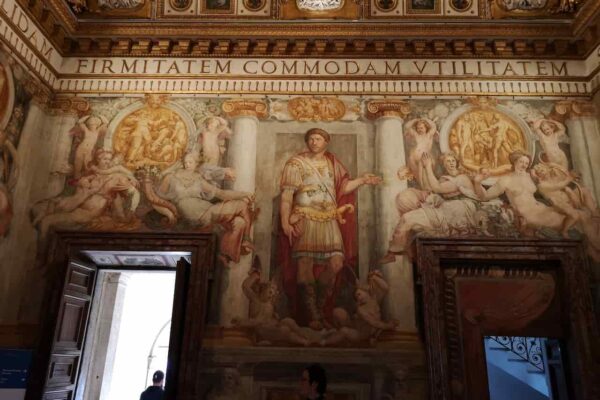
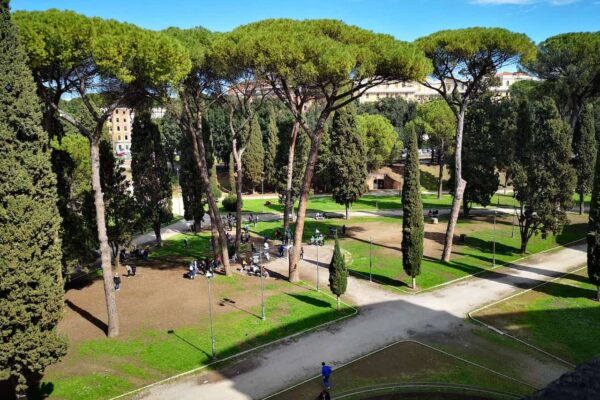
2 Comments. Leave new
Hello! Thank you for the information! Do you know if these tours will be available for the rest of the year? I will be in Rome in September for Cesare Borgia’s 550th birthday, and I would love to take these tours if they are still being held then. Do you know when more tour dates will be announced? Any information would be greatly appreciated. Thank you!
Hello!
Thank you for reaching out! Our tours of Castel Sant’Angelo are always available, and you can book your visit anytime through this link.
As for the guided tour of the Passetto di Borgo, at the moment, it is not possible to book these visits through our website. The organization responsible for these guided tours is Coopculture, and you might want to contact them directly for more information at +39 06 39967100.
I hope you have a fantastic time in Rome!
Best regards,
Alberto